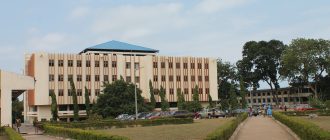Mathematics
The Mathematics Department has qualified and experienced lecturers. Presently, the academic staff comprises one Associate Professor, one SeniorLecturer, two Lecturers, three Technical Instructors and an Adjunct Professor. The department’s research interests are in the areas of Optimisation, Curve Fitting, Fluid Dynamics and +Mathematical/Statistical Modelling, amongstothers.
|
|
|
YEAR ONE SEMESTER ONE | ||||
| Course No. | Subject | T | P | C |
| MA 151 MA 155 MA 157 MA 159 MA 171 MA 173 MA 175 | Applied Electricity Technical Drawing Communication Skills I Introduction to Computing Trigonometry and Coordinate Geometry Vector Analysis Basic Linear Algebra | 2 2 2 1 2 2 2 | 2 2 1 3 1 2 1 | 3 3 2 2 2 3 2 |
Totals | 13 | 12 | 17 | |
YEAR ONE SEMESTER TWO | ||||
| Course No. | Subject | T | P | C |
| MA 156 MA 158 MA 170 MA 172 MA 174 MA 176 MA 178 | Engineering Drawing Communication Skills II Discrete Mathematics Calculus of a Single Variable Higher Linear Algebra Probability and Statistics I Vector Applications | 2 2 2 2 2 2 2 | 2 1 1 2 1 2 1 | 3 2 2 3 2 3 2 |
Totals | 14 | 10 | 17 |
YEAR TWO SEMESTER ONE | ||||
| Course No. | Subject | T | P | C |
| MA 251 MA 271 MA 273 MA 275 MA 277 MA 279 | Literature in English I Calculus of Several Variables Real Analysis I Numerical Methods Probability and Statistics II Basic Physical Chemistry | 1 2 2 2 2 2 | 1 2 2 2 2 2 | 1 3 3 3 3 3 |
Totals | 11 | 11 | 16 | |
YEAR TWO SEMESTER TWO | ||||
| Course No. | Subject | T | P | C |
| MA 252 MA 270 MA 272 MA 274 MA 276 MA 278 | Literature in English II Differential and Integral Calculus Real Analysis II Ordinary Differential Equations Numerical Methods and Scientific Computing Physics I | 1 2 2 2 2 2 | 1 2 2 2 2 2 | 1 3 3 3 3 3 |
Totals | 11 | 11 | 16 | |
YEAR THREE SEMESTER ONE | ||||
| Course No. | Subject | T | P | C |
| MA 371 MA 373 MA 375 MA 377 MA 379 MA 381 | Physics II Linear Partial Differential Equations Regression Analysis Numerical Methods for Ordinary Differential Equations Elements of Topology Statistical Modelling | 2 2 2 2 2 2 | 2 2 2 2 2 2 | 3 3 3 3 3 3 |
Totals | 12 | 12 | 18 | |
YEAR THREE SEMESTER TWO | ||||
| Course No. | Subject | T | P | C |
| MA 352 MA 372 MA 374 MA 376 MA 378 MA 380 | Public Relations Special Mathematical Functions Elements of Abstract Algebra Optimization Techniques Complex Analysis Statistical Inference | 2 2 2 2 2 2 | 1 2 2 2 2 2 | 2 3 3 3 3 3 |
Totals | 12 | 11 | 17 |
YEAR FOUR SEMESTER ONE | ||||
| Course No. | Subject | T | P | C |
| MA 451 MA 457 MA 461 MA 471 MA 473 MA 000 MA 000 | Economic Development Planning Law of Contract and Torts Principles of Economics Introduction to Geophysics Sample Survey Theory * Elective *Elective | 2 2 2 2 2 2 2 | 1 0 0 1 2 2 2 | 2 2 2 2 3 3 3 |
Totals | 14 | 8 | 17 | |
| * Electives: Students are to select any two of the following * MA 475 Mathematical Economics I * MA 477 Time Series and Forecasting I * MA 479 Optimization Techniques * MA 481 Computer Appreciation (Visual Basic and C++) | ||||
YEAR FOUR SEMESTER TWO | ||||
| Course No. | Subject | T | P | C |
| MA 454 MA 450 MA 452 MA 470 MA 000 MA 000 | BusinessEntrepreneurship Project Work Colloquium/Seminar Design and Analysis of Experiments * Elective *Elective | 2 0 0 2 2 2 | 1 12 4 2 2 2 | 2 4 1 3 3 3 |
Totals | 8 | 23 | 16 | |
| *Electives: Students are to select any two of the following: * MA 472 Mathematical Economics II * MA 474 Time Series and Forecasting II * MA 476 Mathematical Programming * MA 478 Programming in C/C++ and Java. |
DETAILED COURSE DESCRIPTION
YEAR ONE SEMESTER ONE
MA 151 Applied Electricity (2, 2, 3)
Circuit laws. Circuit theorems. Electrostatics. Electromagnetic. Magnetic circuits. Inductance. Alternating voltage and current. Signal waveforms. Introduction to transformers, DC machines, Induction Machines and Synchronous machines.
MA 155 Technical Drawing (2, 2, 3)
Lettering with inclined and vertical strokes. Word spacing and compositions. Construction of lines. Angles. Regular polygons and general loci. Descriptive Geometry. First and third angle orthogonal projections. Dimensioning, limits, fits and tolerance.
MA 157 Communication Skills I (2, 1, 2)
Oral and written communication skills. Ability to express ideas in good English. Correction of common deficiencies in English grammar. Comprehension and critical reading skills.
MA 159 Introduction to Computing (1, 3, 2)
Introduction to PCs. Windows operating system. Internet usage. Word Processing using MS word. Spreadsheet using MS excel. Programming using visual basic applications (VBA).
MA 171 Trigonometry and Coordinate and Geometry (2, 1, 2)
Principles of induction. Indices. Logarithms. Surds. Polynomials. Rational functions. Partial fractions. Sequences and finite series. Binomial theorem for a positive integral index. Trigonometric functions: addition and factor theorems, circular measure. Equations of lines and circles. Conic sections: Parabola, ellipse and hyperbola. Parametric representation of curves. Hyperbolic functions.
MA 173 Vector Analysis (2, 2, 3)
Vectors in Euclidian spaces, especially in dimensions 1, 2, and 3. Positive vector. Dot product (scalar product). Cross product (vector product). Composition and resolution of vectors. Vector equation of a line. Vector equation of a plane. The straight line and the plane. The angle between a line and a plane. The angle between two lines and between two planes. Scalar triple products.
MA 175 Basic Linear Algebra (2, 1, 2)
Matrix algebra. Systems of linear equations. Algebra of linear transformations and their representation by matrices. Eigenvalues and eigenvectors. Similar matrices. Cayley – Hamilton’s theorem. Diagonalisation of symmetric positive – definite matrices.
MA 156 Engineering Drawing (2, 2, 3)
Sectional views and standard conventions of sectional views. Curves of intersection of various planes and solids. Development of various solids like cylinders and spheres. Assembly drawings from both exploded view and working drawing views.
MA 158 Communication Skills II (2, 1, 2)
Communication skills. Oral presentation. Formal speech making. Conducting interviews and meetings. Communication process. Skill in communication. Channels in communication in an organization. Preparation of official documents such as letters, memos, reports, minutes and proposals.
MA 170 Discrete Mathematics (2, 1, 2)
Multinomial coefficients. Complex numbers. De Moivre’s theorem. Finite difference equations. The z-transform approach to solution. Difference equations with characteristic polynomial which have complex roots. Boolean algebra. Basic Boolean functions. Digital logic gates. Minterm and maxterm expansions. Elements of proof theory. Relations in a set. Partial ordering. Zorn’s lemma.
MA 172 Calculus of a Single Variable (2, 2, 3)
Limits. Differentiation of a composite function. Implicit differentiation. Maxima and minima. Integration as the inverse of differentiation. Application of integration to: trigonometry, polynomials, hyperbolic and exponential functions, areas and volumes. Integration techniques: integration by substitution, by parts and by resolution into partial fractions.
MA 174 Higher Linear Algebra (2, 1, 2)
Vector spaces and subspaces. Basis dimension and coordinates. Change of basis. Annihilating polynomial. Linear functional, Dual spaces. Multi-linear forms. Inner product spaces. Orthogonalisation process. Hermitian, bilinear and quadratic forms. Reduction to a canonical form. Unitary and normal transformations.
MA 176 Probability and Statistics I (2, 2, 3)
Introduction to study of statistics: general introduction to the nature and use of statistics and some basic concepts. Descriptive analysis of data: graphical and tabular representation of data. Calculation of measures of central tendency and dispersion. Coefficient of skewness and kurtosis. Probability: definition of some basicterms. Permutation and Combinations. Definition of measure probability of events. Conditional probability and independence. Events. Some basic laws and rules in probability. Bayes’ theorem.
MA 178 Vector Applications (2, 1, 2)
Vector mechanics: Statics and Dynamics. Velocity, momentum and moments. Equilibrium and conservation laws. Introduction to vector-valued functions. Differentiation of vector-valued functions. Cartesian tensors and their transformations. Coordinate-free definitions of gradient, curl and divergence. Scalar and vector potential. Notion of orthogonal curvilinear coordinates and bases.
MA 251 Literature in English I (1, 1, 1)
Introduction to literary terms and devices. Specific texts: prose, drama, poetry. Vocabulary and language use. Literature as a reflection of contemporary way of life or society (the text as mirrors). Literature and morality (the text as examples). Literature as a form ofentertainment. African Writers Series.
MA 271 Calculus of Several Variables (2, 2, 3)
Partial differentiation of a function of several variables. Differentiation of implicit functions. Jacobians. Differentiation of a vector functions of several variables. The tangent vector. Curvilinear co-ordinates. Plane polar, cylindrical and spherical co-ordinates. Multiple integrals. Line integrals, multiple, surface and volume integrals.
MA 273 Real Analysis I (2, 2, 3)
Introduction to the theory of real numbers. Least upper bound, greatest lower bound of a set. Convergence of sequences. Upper and lower limits. The Bolzano-Wierstrass theorem and the Cauchy principles of convergence. The notion of a function, limit and continuity. Inverse and composite functions.
MA 275 Numerical Methods (2, 2, 3)
Sources and types of error; round-off errors, truncation error, Basic error analysis. Evaluation of functions. Numerical solution of non-linear algebraic equation; one-point methods; simple iteration, secant and Newton-Raphson methods. Acceleration and relaxation. Bracketing methods; Bisection and false-position methods. Numerical solution of sets of linear algebraic equations: elimination back substitution. Matrix inversion. Instabilities and pivoting. Gaussian elimination. Iterative methods for linear systems: Gauss-Jacobi, Gauss-Siedel and successive over relaxation (SOR). Convergence and error analysis. Order of an iterative process. Use of computer essential.
MA 277 Probability and Statistics II (2, 2, 3)
Random variables and probability distributions: expectations and variances of random variables, properties. Moments and moment generating functions. Some special discrete distributions: Bernoulli, binomial, geometric, negative binomial, Poisson and multinomial distributions. Some special continuous distributions: uniform, exponential, Gaussian, gamma, beta, chi-squared and other related distributions. Joint probability distributions: properties, marginal and conditional distributions. Conditional mean and variance.
MA 279 Basic Physical Chemistry (2, 2, 3)
Atomic theory, Bonding and Periodicity. Properties of gases, solids and liquids. Chemical equilibrium, Ionic equilibrium, Radioactivity.
MA 252 Literature in English II (1, 1, 1)
Reading and appreciation. Literary terms. Specific texts: prose, drama, poetry. Vocabulary and language use. Literature as a reflection of contemporary way of life or society (the text as mirrors). Literature and morality (the text as examples). Literature as a form of entertainment. Shakespearean and modern classics.
MA 270 Differential and Integral Calculus (2, 2, 3)
Improper integrals. Integrals depending on a parameter. Differentiation and Integration under the integral sign. Gamma and beta functions; Stirling’s formula. Basic properties and use of the Laplace transform. Fourier series and orthogonal functions: Lengendre polynomials and Bessel functions. Fourier transforms. Calculus of Cartesian tensors.
MA 272 Real Analysis II (2, 2, 3)
Differentiation and integration of vector functions of a real variable. Simple applications. Numerical series and convergence test. Functions series. Functions of many variables, continuity, and partial differentiation. Totals differential, tangent plane to a surface. Taylor’s theorem. Extrema.
MA 274 Ordinary Differential Equations (2, 2, 3)
Ordinary differential equations of first order: Separable, Homogeneous, Linear, Exact. Integrating factors. Linear differential equations of the second order with constant coefficients. Systems of first order equations. Solution of ordinary differential equations of second order using methods of variation of parameters. Reduction of nth order equation to a system of first order equations. Series solution of differential equations. D-operator methods for particular integrals. Laplace transforms and application to solution of differential equations.
MA 276 Numerical Methods and Scientific Computing (2, 2, 3)
Flowcharts and algorithms. The structure and details of one of FORTRAN or Basic. Practical solutions of problems using a computer.
MA 278 Physics I (2, 2, 3)
Principles of Newtonian mechanics, single particle under the action of variable forces (F (x), F (t), F (v)). Motion in 1-dimention. Potential energy. Stable, unstable and neutral equilibrium. Free, damped and forced harmonic oscillator. Resonance. Motion in 2, 3 dimensions. Force fields. Conservation theorem of energy. Linear and angular momentum. Central forces. Effective potential. Kepler’s laws and planetary motion. 2-3 dimensional harmonic oscillators. General theorems on the motion of a system of particles with applications to the motion of a rigid body. Variational principles. Lagrange and Hamilton’s equations. Normal coordinates.
MA 371 Physics II (2, 2, 3)
Continuum mechanics: Lagrangian and Eulerian description of motion. Equation of continuity. Deformation: deformation gradient tensors. Strain tensors. Stress tensors. Cauchy’s equations of motion or conservation of momentum. Hook’s law for elastic media strain-rate tensor. Newtonian viscosity. Viscous flow. Navier-Stokes equations. Simple examples. Bernoulli’s flow in 2 dimensions. Complex potential. Blasuis theorem, Milne-Thompson theorem. Waves. Electrostatics: law of force, electric potential. Electric field equations (including point and dipole sources), boundary conditions and Gauss’ law in vacuo and in dielectric media.
MA 373 Linear Partial Differential Equations (2, 2, 3)
Definition of a partial differential equation of the first order. Cauchy problem and its characteristics. Method of Lagrange. Classification of second order equations (parabolic, hyperbolic, elliptic). Laplace’s and Poisson’s equations. Separation of variables. Fundamental solution of potentials and their properties. The wave and heat equations. Method of eigenfunction expansions.
MA 375 Regression Analysis (2, 2, 3)
Basic concepts of regression and correlation analysis. Simple regression model: estimation of regression coefficients and error variance. Inferences about the regression coefficients. Coefficient of determination. Multiple regression model: Some basic concepts and results of matrices and vectors. Expectation and covariance matrix for linear combination(s) of random variables. Estimation of the multiple regression model by the least squares method. Inference about regression coefficients using analysis of variance. Concepts of multi-collinearity and the use of dummy or qualitative variables. Residual analysis: testing regression model assumptions.
MA 377 Numerical Methods for Ordinary Differential Equations (2, 2, 3)
Methods for first-order differential equations: Taylor’s method, Euler methods, Runge-Kutta methods, multi-step methods. Methods for higher-order differential equations: Taylor’s, Euler and Runge-Kutta methods.
MA 379 Elements of Topology (2, 2, 3)
The concept of a topology: open sets, closed sets, interior, closure, derived sets and boundary of a subset. Continuous mapping. Metric spaces. Uniformly continuous mapping homeomorphism. Dense sets. Separable spaces. Connectedness. Compactness.
MA 381 Statistical Modelling (2, 2, 3)
Statistical inference: basic concepts of statistical inference, sampling distributions. Introduction to sampling methods. Sampling distributions of sample means. Proportions and variances. Estimation: point and interval estimation of parameters (mean, proportion and variance). Analysis of variance test for several means. Non-parametric tests: introduction, chi-square tests, test for randomness, Mann-Whitney U-test, Wilcoxon signed rank test, Kruskal-Wallis and Fried’s tests and sign test.
MA 352 Public Relations (2, 1, 2)
Reading and appreciation. Literary terms. Specific texts: prose, drama, poetry. Vocabulary and language use. Literature as a reflection of contemporary way of life or society (the text as mirrors). Literature and morality (the text as examples). Literature as a form of entertainment. Shakespearean and modern classics.
MA 372 Special Mathematical Functions (2, 2, 3)
Series solution of certain linear differential equations of second order (example Legendre’s equation and Bessel’s equation). Special functions: Legendre polynomials. Bessel functions, Hermit and Chebychev polynomial, Laguerre and hypergeometric functions. Gamma and beta functions: Sterling’s formula, asymptotic expansions. The method of steepest descent. The method of stationary phase. Recurrence relation. Watson’s Lemma. The error function. The exponential integral.
MA 374 Elements of Abstract Algebra (2, 2, 3)
Rings and fields: Definitions, examples and properties. Polynomial rings. Euclidean algorithms. Ideal and quotient rings. The homomorphism theorems. The field of quotients of an integral domain. Principal ideal domains. Factorization in principal ideal domain. Groups. Examples of groups such as cyclic groups. Groups of permutations and dihedral groups. Subgroups, cosets and Lagrange’s theorems for groups.
*MA 376 Optimization Techniques (2, 2, 3)
Description of the problem of optimization and geometry of Rn, n>1. Convex sets and convex functions. Solution of systems of algebraic and transcendental equations. Matrices. Farkas lemma, gradient and Hessian of a function on Rn. Unconstrained and constrained problems in Rn. Derivative of subjective function available or unavailable, algorithms of Davies, Swann and Campey (DSC), Powell and Goggin (DSC-Powell). Simultaneous search and sequential algorithms. Constrained linear problems in Rn, n>1.
MA 378 Complex Analysis (2, 2, 3)
Algebra of complex numbers. Convergence of series. Uniform convergence of sequences and functions. Power series. Functions defined by power series. Analytical functions. Differentiation. Cauchy-Riemann equations. Cauchy’s theorem. Cauchy’s integral formulae. Harmonic functions. Conformal mapping. Calculus of residues. Elements of analytical continuation. Maximum modulus principle. Rouche’s theorem and fundamental theorem of algebra.
MA 380 Statistical Inference (2, 2, 3)
Estimation: Properties of point estimators. Uniformly minimum variance estimators. Cramer Rao lower bound. Sufficient statistics. Likelihood functions and methods of estimation. General methods of interval estimation. Means and variances of normal distributions, properties. Tests of hypotheses: Power and operating characteristic curves. Sample size estimation: Neyman-Pearson lemma. Likelihood ratio tests and applications.
MA 451 Economic Development and Planning (2, 1, 2)
Theories and concepts of development. Foreign aid, grants and investment. Techniques of economic development planning. Third world and economic development planning (case studies). Planning periods inGhana.
MA 457 Law of Contract and Torts (2, 0, 2)
Law and the legal system. Contract and conditions for valid contracts. Contracts andbusinessorganizations. Abrogation of contracts.
MA 461 Principles of Economics (2, 0, 2)
Introduction to microeconomics. Demand and supply and price theory. Elasticities. Economics of scale. Optimal input combinations and cost functions. Perfect competition, monopoly, imperfect competition (monopolistic competition, oligopoly, cartel, etc).Businessorganization and securities. Introduction to macroeconomics. Functions of government. Measurement of national output and income. Money and banking. Unemployment and inflation.
MA 471 Introduction to Geophysics (2, 1, 2)
Geosphere. General geophysics and physics of the earth: Structure and origin of the earth. The continental and oceanic crusts. The mantle and core of the earth. Terrestrial heat flow. Continental drift and ocean floor spreading. Introduction to exploration geophysics.
MA 473 Sample Survey Theory (2, 2, 3)
Introduction: Basic ideas of sampling. Sampling techniques: simple random, stratified, systematic, cluster and multistage. Regression and ratio estimations. Errors in surveys.
*MA 475 Mathematical Economics I (2, 2, 3)
Microeconomic theory is treated with a mathematical approach. Topics will include the following: theory of consumer behaviour, constrained optimizing behaviour. The Slutsky equation, construction of utility number. Theory of the firm. Constrained optimizing behaviour, CES production function, market equilibrium with lagged adjustment and continuous adjustment. Multi market equlibruim. Pareto optimality. General economic optimization over time. Linear models. Input-output (I-O) models, Linear programming concepts and solutions.
*MA 477 Time Series and Forecasting I (2, 2, 3)
Basic concepts: definitions, basis of time series analysis, types of time series. Components of time series: Trend, seasonality, cyclic variations, etc. Trend analysis: moving averages, exponential smoothing, autoregressive and partial autoregressive functions. Use of SPSS.
*MA 481 Computer Appreciation (2, 2, 3)
Development of window-based mathematical application software, using one of visual basic or visual C++.
* Elective
MA 454 Business Entrepreneurship (2, 1, 2)
Forms of business organization. Management of business enterprises. Budget preparation process. Management of working capital. Investment in assets.
MA 450 Project Work (0, 12, 4)
Students select topics on various areas in Mathematics for their project work.
MA 452 Colloquium/Seminar (0, 4, 1)
Students will prepare a paper on a selected topic and present it in a seminar under supervision.
MA 470 Design and Analysis of Experiments (2, 2, 3)
Objectives and definitions. Role of randomization and replication. Experiments involving paired data. Fixed effects, random effects and mixed effects models. Analysis of variance (ANOVA). Special design: Completely randomized design (CRD); assumption, randomization, multiple comparisons, estimation of parameters, unequal sample sizes; randomized complete block design (RCBD), estimation and effects of missing observation, relative efficiency. Latin Square and Pair-Wise orthogonal Latin square design. Split-plot design. Analysis of covariance (ANACOVA). Factorial experiments, rules of calculation of mean square and expected mean square and tests of significance, confounding, fractional replication.
*MA 472 Mathematical Economics II (2, 2, 3)
Micro-economic theory is treated with a mathematical approach in the following areas: Simple model of income determination, consumption and investment, the IS curve. Monetary equilibrium, the LM curve. Labour wages and price (inflation) models. Full employment equilibrium models of income determination. Aggregate demand and supply analysis. Balance of trade (payments), model of income determination. Stabilization policy, comparative statistics, analysis of monetary fiscal policy, the Harold Domar growth model, the neo-classical growth model. (Prerequisite MA 479).
*MA 474 Time Series and Forecasting II (2, 2, 3)
Time series models: moving average, autoregressive, autoregressive integrated moving average, autoregressive moving average. Box-Jenkins method of modeling time series data. Forecasting: prediction limits, forecast updating, Holt-Winter’s methods. Use of SPSS.
*MA 476 Mathematical Programming (2, 2, 3)
Linear programming in Rn, n>1. Duality theorem and complementary slackness principle. Elements of unconstrained and constrained non-linear programming in Rn, n>1. Network analysis, inventory control, queuing theory, simulation and game theory. Linear programming and solution methods (graphical and simplex). Application of linear programming to transportation assignment problems.
*MA 478 Programming in C/C++ and Java (2, 2, 3)
Development of mathematical and other application software using C/C++ and Java.






